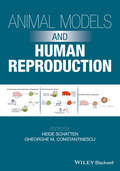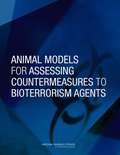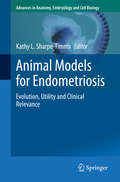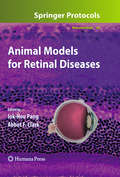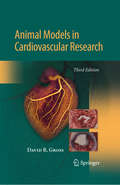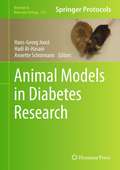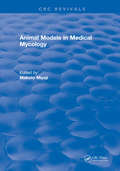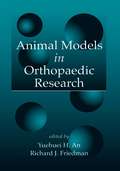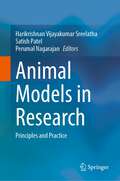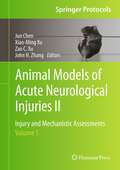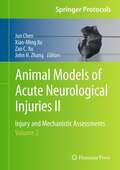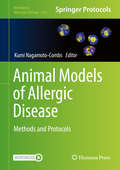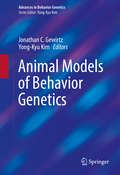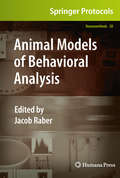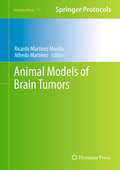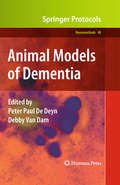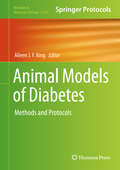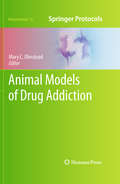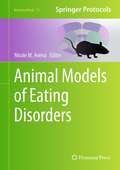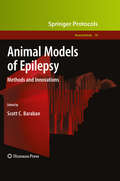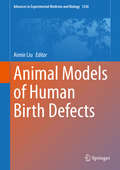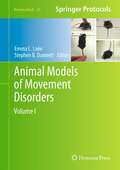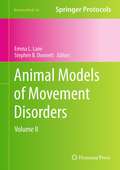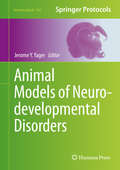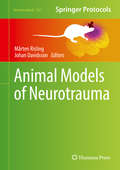- Table View
- List View
Animal Models and Human Reproduction: Cell and Molecular Approaches with Reference to Human Reproduction
by Gheorghe M. Constantinescu Heide SchattenOur knowledge of reproductive biology has increased enormously in recent years on cellular, molecular, and genetic levels, leading to significant breakthroughs that have directly benefitted in vitro fertilization (IVF) and other assisted reproductive technologies (ART) in humans and animal systems. Animal Models and Human Reproduction presents a comprehensive reference that reflects the latest scientific research being done in human reproductive biology utilizing domestic animal models. Chapters on canine, equine, cow, pig, frog, and mouse models of reproduction reflect frontier research in placental biology, ovarian function and fertility, non-coding RNAs in gametogenesis, oocyte and embryo metabolism, fertilization, cryopreservation, signal transduction pathways, chromatin dynamics, epigenetics, reproductive aging, and inflammation. Chapters on non-human primate models also highlight recent advancements into such issues as human in vitro fertilization (IVF) and assisted reproductive technologies (ART). This book offers animal scientists, reproductive biology scientists, clinicians and practitioners, invaluable insights into a wide range of issues at the forefront of human reproductive health.
Animal Models for Assessing Countermeasures to Bioterrorism Agents
by Committee on Animal Models for Assessing Countermeasures to Bioterrorism AgentsThe Transformational Medical Technologies (TMT) has been a unique component of the U. S. Department of Defense (DoD) medical biodefense efforts since 2006. Its mission is to advance countermeasure research and development in support of the broader goal of the DoD to protect warfighters from emerging infectious diseases and future genetically engineered biological weapons. The TMT, using advanced science and technology approaches, focused on the development of roadspectrum countermeasures that target common host and pathogen pathways or enhance the host's immune response. Many of these pathogens are lethal or cause such debilitating diseases in humans that it is ethically inappropriate to test the efficacy of these countermeasures in human volunteers. In lieu of human participants, these products may be tested in animals and approved for human use under the provisions of the Food and Drug Administration (FDA)'s 2002 Animal Rule. The reliance on animal models for the development and licensure of medical countermeasures against biothreats is challenging for a number of reasons. The ad hoc Committee on Animal Models for Assessing Countermeasures to Bioterrorism Agents prepared a consensus report that would address the challenges stemming from developing and testing medical countermeasures against biothreat agents in animal models. "Animal Models for Assessing Countermeasures to Bioterrorism Agents" evaluates how well the existing TMT-employed or candidate animal models reflect the pathophysiology, clinical picture, and treatment of human disease as related to the agents of interest. The report addresses the process and/or feasibility of developing new animal models for critical biodefense research, placing emphasis on the need for a robust and expeditious validation process in terms of the FDA's Animal Rule. The report also evaluates alternatives to the use of animal models based on the premise of the Three Rs.
Animal Models for Endometriosis: Evolution, Utility and Clinical Relevance (Advances in Anatomy, Embryology and Cell Biology #232)
by Kathy L. Sharpe-TimmsThis new volume of our successful book series Advances in Anatomy, Embryology and Cell Biology focuses on the need for and use of animal models when studying endometriosis. Covering models ranging from rodents to baboons, it explores novel mechanisms involved in the pathophysiology of endometriosis. Topics range from the role of miRNAs and environmental endocrine disrupters to pain and endometriosis-associated subfertility.Estimated to affect up to 10% of women, endometriosis is a widespread and in some cases debilitating disease. While studies on the pathophysiology of the disease and the development of treatments for endometriosis-associated subfertility are called for, acquiring appropriate tissues from women with and without endometriosis in combination with physiologically relevant in vitro and in vivo laboratory models is an essential aspect. However, control subjects with similar ages, living environments and medical histories, besides endometriosis, are hard to find and attaining suitable human reproductive tissues is linked to an ongoing ethical discussion, especially when studying embryos. Laboratory models like rodent and monkey models are therefore needed to fill the research gap and support hypothesis-driven, randomized, controlled experimental design studies. In this book we highlight the latest developments and findings in endometriosis research using animal models. The book was written for scientists, physicians and medical students working in the field of reproductive science, and for women with endometriosis.
Animal Models for Retinal Diseases (Neuromethods #46)
by Iok-Hou Pang Abbot F. ClarkAffecting over a hundred million individuals worldwide, retinal diseases are among the leading causes of irreversible visual impairment and blindness, and appropriate study models, especially animal models, are essential to furthering our understanding of the etiology, pathology, and progression of these endemic diseases. In Animal Models for Retinal Diseases, recognized experts in the field highlight valuable techniques as well as animal models for the prominent retinal diseases in order to aid in the evaluation, development, and improvement of therapeutic strategies. Beginning with an overview of the morphology of the retina, visual behavior, and genetics and genomics approaches for retinal research, the book continues by covering animal models for the research of specific human retinal diseases, e.g., retinal degeneration, age-related macular degeneration, retinopathy of prematurity, diabetic retinopathy, glaucoma, retinal ischemia, and retinal inflammation. As a volume in the successful Neuromethods series, the chapters provide authoritative reviews of the most commonly used approaches in the field. Vital and easy to use, Animal Models for Retinal Diseases serves to support the important future research of ocular investigators, ophthalmologists, and neuroscientists currently delving into this fascinating field of study.
Animal Models in Cardiovascular Research (Developments In Cardiovascular Medicine Ser. #Vol. 153)
by David GrossInterest in the humane and scientifically justifiable use of research animals has intensified since the publication of the 2nd edition of Animal Models in Cardiovascular Research. This completely revised and updated edition will provide information essential to any researcher interested in using animal models for cardiovascular research, or any research which requires normal cardiovascular function. The format and presentation will be changed to make the text more easy to read and use: (1) This edition is in outline format, for ease and utility. (2) The opening chapter includes more information on the cardiovascular effects of post-operative analgesia and will address the recognition of pain behavior in species commonly used in research settings, particularly rats and mice. (3) New edition includes reference material more useful to researchers using transgenic and naturally occurring animal models to dissect these mechanisms.
Animal Models in Diabetes Research (Methods in Molecular Biology #933)
by Hadi Al-Hasani Annette Schürmann Hans-Georg JoostIn recent years, human studies have made enormous contributions towards an understanding of the genetic basis of diabetes mellitus; however, most of the experimentation needed for the invention and testing of novel therapeutic approaches cannot be performed in humans. Thus, there is no alternative to appropriate animal models. In Animal Models in Diabetes Research, expert researchers explore the current status of the most important models and procedures in order to provide a timely resource in experimental diabetology. The first half of the volume serves as a comprehensive overview on our current knowledge of the pathogenesis and pathophysiology of diabetes in animal models through a series of reviews in model strains. The book then continues with vital, established protocols that are employed in the characterization and study of animal models of diabetes. As a volume in the highly successful Methods in Molecular BiologyTM series, this work contains the type of detailed description and key implementation advice necessary to achieve successful results. Authoritative and cutting-edge, Animal Models in Diabetes Research delivers essential content that will be an important resource to advance diabetes research in the years to come.
Animal Models in Medical Mycology
by Makoto MiyajiThe prevalence of antibiotics, corticosteroids, and anticancer or immunosuppressive drugs and the progress of the medical treatments after World War II have saved the lives of many patients attacked by serious diseases and have contributed to the prolongation of the average life span of a human being. However, there still remain some problems to be solved. One of them is that of compromised hosts, which will be treated in this book.
Animal Models in Orthopaedic Research
by Yuehuei H. An Richard J. FriedmanAnimal Models in Orthopaedic Research is a reference book of the major animal models used in the study of orthopaedic conditions and in the in vivo study of biomaterials. Use of animal models provides important knowledge about pathological conditions that can eventually lead to the development of more effective clinical treatment of diseases in bot
Animal Models in Research: Principles and Practice
by Harikrishnan Vijayakumar Sreelatha Satish Patel Perumal NagarajanThis book describes the development of animal models widely used in biomedical research using step-wise instructions and photographs. Showcasing a wide range of species from zebra fishes, birds, rodents, rabbits, dogs, and pigs, the book includes detailed methodology on how to work with these species and to develop various models. The animal models in neurology including stroke, Alzheimer’s disease, Parkinson’s disease, and Schizophrenia; Animal models in cancer research, sleep disorders, and cardiovascular diseases are described to meet the understanding of researchers who plan to replicate these models in their laboratories. In depth detailing on the development of targeted gene knockouts and transgenics, implantation models that are used in toxicology studies, and pharmacokinetic studies in pigs and dogs are a highlight. Further, the book describes pharmacologic, chemically induced, surgically induced, microbiologically induced, infectious models, models for neurobehavioral studies, oncology research, and pain research. The book has dedicated sections on anesthesia and analgesia and teaches procedures like venous cut-downs and cannulations in pigs and dogs, and endotracheal intubation, mechanical ventilation and thoracotomy in rodents and will serve as a self-training tool. Concepts in the field of animal model development are explained using examples. Sample size selection, study design, and statistical evaluation of experiments involving laboratory animals are explained to enable young researchers to practically understand the nuances. This book will be a valuable tool for academicians, students, scientists, and veterinarians and will benefit equally who are new to the field and who are already working with laboratory animals.
Animal Models of Acute Neurological Injuries II: Injury and Mechanistic Assessments, Volume 1 (Springer Protocols Handbooks)
by John H. Zhang Zao C. Xu Jun Chen Xiao-Ming XuThe successful previous volume on this topic provided a detailed benchwork manual for the most commonly used animal models of acute neurological injuries including cerebral ischemia, hemorrhage, vasospasm, and traumatic brain and spinal cord injuries. <P><P> Animal Models of Acute Neurological Injuries II: Injury and Mechanistic Assessments aims to collect chapters on assessing these disorders from cells and molecules to behavior and imaging. These comprehensive assessments are the key for understanding disease mechanisms as well as developing novel therapeutic strategies to ameliorate or even prevent damages to the nervous system. <P><P> Volume 1 examines general assessments in morphology, physiology, biochemistry and molecular biology, neurobehavior, and neuroimaging, as well as extensive sections on subarachnoid hemorrhage, cerebral vasospasm, and intracerebral hemorrhage. Designed to provide both expert guidance and step-by-step procedures, chapters serve to increase understanding in what, why, when, where, and how a particular assessment is used.<P><P> Accessible and essential, Animal Models of Acute Neurological Injuries II: Injury and Mechanistic Assessments will be useful for trainees or beginners in their assessments of acute neurological injuries, for experienced scientists from other research fields who are interested in either switching fields or exploring new opportunities, and for established scientists within the field who wish to employ new assessments.
Animal Models of Acute Neurological Injuries II: Injury and Mechanistic Assessments, Volume 2 (Springer Protocols Handbooks)
by John H. Zhang Zao C. Xu Jun Chen Xiao-Ming XuThe successful previous volume on this topic provided a detailed benchwork manual for the most commonly used animal models of acute neurological injuries including cerebral ischemia, hemorrhage, vasospasm, and traumatic brain and spinal cord injuries. Animal Models of Acute Neurological Injuries II: Injury and Mechanistic Assessments aims to collect chapters on assessing these disorders from cells and molecules to behavior and imaging. These comprehensive assessments are the key for understanding disease mechanisms as well as developing novel therapeutic strategies to ameliorate or even prevent damages to the nervous system. Volume 2 examines global cerebral ischemia, focal cerebral ischemia, and neonatal hypoxia-ischemia, as well as intensive sections covering traumatic brain injury and spinal cord injury. Designed to provide both expert guidance and step-by-step procedures, chapters serve to increase understanding in what, why, when, where, and how a particular assessment is used. Accessible and essential, Animal Models of Acute Neurological Injuries II: Injury and Mechanistic Assessments will be useful for trainees or beginners in their assessments of acute neurological injuries, for experienced scientists from other research fields who are interested in either switching fields or exploring new opportunities, and for established scientists within the field who wish to employ new assessments.
Animal Models of Allergic Disease: Methods and Protocols (Methods in Molecular Biology #2223)
by Kumi Nagamoto-CombsThis volume provides protocols for mouse models of allergic diseases and guidelines for choosing a particular strains, allergen, adjuvant, and route of sensitization. Chapters detail types of allergic disease, methods that are frequently employed to analyze pathophysiology of allergic diseases, manipulation of intestinal microbiota, and desensitization of immure responses in animal models. Written in the highly successful Methods in Molecular Biology series format, chapters include introductions to their respective topics, lists of the necessary materials and reagents, step-by-step, readily reproducible laboratory protocols, and tips on troubleshooting and avoiding known pitfalls. Authoritative and cutting-edge, Animal Models of Allergic Disease: Methods and Protocols aims to offer a comprehensive collection of protocols and experience-derived instructions to further allergic disease research.
Animal Models of Behavior Genetics (Advances in Behavior Genetics)
by Jonathan C. Gewirtz Yong-Kyu KimThis stimulating analysis reviews the broad potential of animal models to foster a deeper understanding of human pathology, strengthen connections between genetic and behavioral studies, and develop more effective treatments for mental disorders. Widely-studied and lesser-used species are examined in models that capture features along the continuum of normative and pathological behavior. The models highlight genetic causes of core features, or endophenotypes, of developmental, internalizing, and externalizing disorders, as well as dementia. Expert contributors address questions ranging from how suitable species are chosen for study to the costs and benefits of using inbred versus outbred strains, and the effects of housing environment on subject animals. Larger issues addressed include how to evaluate the applicability of animal behavioral models to the human condition and how these models can harness emerging molecular technologies to further our understanding of the genetic basis of mental illness. Included in the coverage: Mating and fighting in Drosophila. Attachment and social bonding. Impulsivity in rodents and humans. Animal models of cognitive decline. Animal models of social cognition. Future directions for animal models in behavioral genetics. A detailed map of where this evolving field is headed, Animal Models of Behavior Genetics shows geneticists, molecular biologists, and cognitive neuroscientists paths beyond established concepts toward a more knowledgeable and collaborative future.
Animal Models of Behavioral Analysis (Neuromethods #50)
by Jacob RaberDespite the difficulty in comparing clinic-based human tests with animal model testing, there is still great value in pursuing translational approaches, as tests and treatment strategies might be developed to improve brain function in humans suffering from neurological conditions and knowledge obtained from human behavioral studies can be used to further improve the animal models of behavioral analysis. In Animal Models of Behavioral Analysis, expert neuroscientists focus on approaches to translate and compare behavioral tests used in animals with those used in humans not only to increase our understanding of brain function across species but also to provide objective performance measures and bridge the gap between behavioral alterations in humans with cognitive disorders and the correlating animal models of these conditions. Written in the Neuromethods series format, the chapters provide authoritative reviews of many commonly used approaches in the field today. Provocative and cutting-edge, Animal Models of Behavioral Analysis seeks to aid researchers in further developing these vital techniques in an effort to advance studies in both the clinic and the laboratory.
Animal Models of Brain Tumors (Neuromethods #77)
by Alfredo Martínez Ricardo Martínez MurilloAlthough the available models, whether at the cellular, tissue, or animal level, do not exactly represent the biology of human brain tumors, animal models can offer significant insights into these tumors, providing a better understanding of biological mechanisms underlying tumor generation, growth, angiogenesis, invasion, and metastasis. Animal Models of Brain Tumors brings together developments and discoveries in "in vivo" experimental tumor research that have provided advances in our understanding of the cellular and molecular mechanisms involved in the generation, progression, and clinical outcome of brain neoplasms. Broken into convenient sections, this thorough volume includes topics such as animal model insights into human brain neoplasms, the cellular, molecular, and genetic basis of brain tumors, therapies in the treatment of malignant glioma, as well as imaging technologies in animal tumor models, i.e. measuring brain tumor growth and metabolism. Written for the popular Neuromethods series, chapters include the kind of detailed description and implementation advice that is essential for achieving successful results. Authoritative and cutting-edge, Animal Models of Brain Tumors provides the key methods needed to validate, compare, and contrast the animal model with its proposed human counterpart and further the understanding of our own serious ailments.
Animal Models of Dementia (Neuromethods #48)
by Peter Paul De Deyn Debby Van DamWith an ever-increasing elderly population and the resultant rising levels of dementia-related disorders, preclinical research based on animal models is pivotal to our knowledge of underlying molecular mechanisms and drug discovery aiming at the development of therapeutic strategies alleviating or preventing the neurological devastation. In Animal Models of Dementia, expert researchers provide contributions that stress the importance of extensively validated animal models in drug discovery and development in order to predict clinical activity. Beginning with general aspects of animal modeling, related ethical issues, and essential methodological considerations, the highly detailed volume then continues with various levels of model validation, including pathological, behavioral, neurochemical, pharmacological, and imaging aspects, followed by sections focused on specific disorders, such as Alzheimer's disease, Parkinson's disease, metachromatic leukodystrophy and adrenoleukodystrophy, amyotrophic lateral sclerosis, frontotemporal dementia as well as vascular dementia and more. As a volume in the renowned Neuromethods series, this book offers a detailed, yet accessible, overview of currently available animal models in the field of dementia research, and touches, as well, upon more general areas linked to the development and use of animal models. Comprehensive and efficient, Animal Models of Dementia will significantly aid both experienced animal researchers as well as investigators on the verge of beginning animal model-based dementia research.
Animal Models of Diabetes: Methods and Protocols (Methods in Molecular Biology #2128)
by Aileen J. F. KingThis volume discusses a variety of animal models of diabetes, as well as describes techniques used to study end-points when using these models. The chapters in this book cover topics such as important considerations when working with mouse models of diabetes, highlighting factors that new investigators may not be aware of and some potential pitfalls in experimental outcomes; main characteristics of some commonly used animal models of diabetes research, ranging from mice to primates; animal models used to study specific aspects of beta-cell biology; and a focus on techniques used to assess blood glucose homeostasis, insulin action, and islet function in vivo and ex vivo. Written in the highly successful Methods in Molecular Biology series format, chapters include introductions to their respective topics, lists of the necessary materials and reagents, step-by-step, readily reproducible laboratory protocols, and tips on troubleshooting and avoiding known pitfalls.Cutting-edge and comprehensive, Animal Models of Diabetes: Methods and Protocols is a valuable resource that will help diabetes researchers design and carry out in vivo studies that will best suit their experimental questions and needs.
Animal Models of Drug Addiction (Neuromethods #53)
by Mary C. OlmsteadOur understanding of addiction and how it is treated has advanced remarkably over the past decades, and much of the progress is related directly to animal research. This is true for both the behavioural aspects of drug use as well as the biological underpinnings of the disorder. In Animal Models of Drug Addiction, experts in the field provide an up-to-date review of complex behavioural paradigms that model different stages of this disorder and explain how each test is used to effectively replicate the progression of drug addiction. This detailed and practical book begins with the most common laboratory measures of addiction in animals, including intracranial self-stimulation (ICSS), drug self-administration, place conditioning, and sensitization. Later chapters describe how these paradigms are used to model the progression of drug addiction, providing insight into the clinical symptomatology of addiction from acquisition of drug use through compulsive drug taking to withdrawal and relapse. Written for the popular Neuromethods series, the contributions offer both methodological detail and a theoretical perspective, appealing to readers familiar with preclinical research on drug addiction as well as those who are newcomers to the field. Cutting-edge and authoritative, Animal Models of Drug Addiction will serve as a basis for future vital research that links the bench to the bedside in the crucial treatment of drug addiction.
Animal Models of Eating Disorders (Neuromethods #74)
by Nicole M. AvenaThe growth of the field of eating disorder research has led to a vast array of empirical articles, and the development of new animal models that can be used to study these disorders continues to stimulate new research. Animal Models of Eating Disorders serves as a collection of detailed techniques contributed by experts in the field who are well-versed in the development and implementation of these models. Since eating disorders are complex and likely due to a combination of environmental, genetic, and social causes, the detailed chapters of this volume have been designed to highlight different contributing factors. Collectively, these chapters give a comprehensive and representative overview of both recently developed and classic methodologies used in the study of eating disorders. Written for the popular Neuromethods series, this work contains the kind of thorough description and implementation advice that promises successful results. Authoritative and practical, Animal Models of Eating Disorders aims to aid researchers in the use of animal models to assist in their investigation and characterization of the behaviors and neurochemical alterations associated with these devastating disorders.
Animal Models of Epilepsy: Methods and Innovations (Neuromethods #40)
by Scott C. BarabanWith its complex anatomical, molecular, electrophysiological and behavioral components, epilepsy provides the neuroscientist with nearly boundless opportunities to examine basic neurobiological mechanisms. In Animal Models of Epilepsy: Methods and Innovations, prominent investigators in the field examine several novel models of epilepsy in mice as well as in genetically tractable "simple" species such as Drosophila melanogaster (fruit flies), Caenorhabditis elegans (worms), Xenopus laevis (tadpoles) and Danio rerio (zebrafish). While covering some traditional models, the volume also explores the newest innovations like modeling seizure activity in silica and advanced strategies for seizure detection and gene therapy. As a volume in the successful NeuromethodsTM series, the chapters provide clear, step-by-step protocols and thought-provoking reviews of the most recent advancements in the field. Comprehensive and cutting-edge, Animal Models of Epilepsy: Methods and Innovations is an ideal guide for scientists who wish to expand our understanding of the pathogenesis of this neurological disorder.
Animal Models of Human Birth Defects (Advances in Experimental Medicine and Biology #1236)
by Aimin LiuThis book focuses on the use of animal models to study various human defects. It summarizes our current understanding of a variety of common human birth defects and the essential role of animal models in shedding light on the underlying mechanisms of these disorders. Birth defects are the leading cause of infant deaths, and cost billions of dollars in care for those affected. Unfortunately, the lack of a clear understanding of the mechanisms leading to many of these developmental disorders has hindered effective prevention and early intervention strategies. Studies using animal models have provided essential insights into several human birth defects. This book serves as a valuable reference resource for researchers and graduate students who are interested in learning the basic principles as well as the latest advances in the study of the mechanisms of human birth defects.
Animal Models of Movement Disorders, Volume I: Volume I (Neuromethods #61)
by Stephen B. Dunnett Emma L. LaneMovement is the way that animals interact with their environment and is under the organization and complex control of the brain and spinal cord. Multiple central nervous systems, including cortex, basal ganglia, cerebellum, and brainstem, interact to provide precise motor control and integration. Damage or disease within these systems cause profound motor disturbances in man, which can be effectively modeled in animals to develop a better understanding and treatment of the human condition. Animal Models of Movement Disorders introduces a variety of methods and techniques used to model and assess motor function in experimental animals from lower orders, such as drosophila and c. elegans, through vertebrate species including fish, to mammals, such as rodents and non-human primates. The most advanced contemporary models in each system are presented at multiple levels of analysis from molecular and genetic modeling, lesions, anatomy, neurochemistry, to imaging and behavior. Volume I contains general methods of movement disorder assessment as well as an extensive section on dopamine systems. <P><P> Comprehensive and meticulous, Animal Models of Movement Disorders serves as a valuable reference for those studying motor disorders by covering methodologies in detail and providing the information necessary to consider both the appropriate models and assessment tools that can most informatively answer the key experimental issues in the field.
Animal Models of Movement Disorders, Volume II: Volume II (Neuromethods #62)
by Stephen B. Dunnett Emma L. LaneMovement is the way that animals interact with their environment and is under the organization and complex control of the brain and spinal cord. Multiple central nervous systems, including cortex, basal ganglia, cerebellum, and brainstem, interact to provide precise motor control and integration. Damage or disease within these systems cause profound motor disturbances in man, which can be effectively modeled in animals to develop a better understanding and treatment of the human condition. Animal Models of Movement Disorders introduces a variety of methods and techniques used to model and assess motor function in experimental animals from lower orders, such as drosophila and c. elegans, through vertebrate species including fish, to mammals, such as rodents and non-human primates. The most advanced contemporary models in each system are presented at multiple levels of analysis from molecular and genetic modeling, lesions, anatomy, neurochemistry, to imaging and behavior. Volume II of this detailed collection contains sections on the basal ganglia, neo- and allo-cortical systems, cerebellar and brain stem systems, as well as spinal cord systems.<P><P> Comprehensive and meticulous, Animal Models of Movement Disorders serves as a valuable reference for those studying motor disorders by covering methodologies in detail and providing the information necessary to consider both the appropriate models and assessment tools that can most informatively answer the key experimental issues in the field.
Animal Models of Neurodevelopmental Disorders (Neuromethods #104)
by Jerome Y. YagerProviding a spectrum of models that is reflective of the various species that can be utilized in experimentation on disorders across a broad range of developmental disabilities, this volume collects expert contributions involved in investigation of the causes, outcomes, treatment, and prevention. Animal Models of Neurodevelopmental Disorders explores models of perinatal hypoxia-ischemia/cerebral palsy and stroke, autism spectrum disorder, fetal alcohol syndrome, as well as mental retardation. Written in the popular Neuromethods series style, chapters include the kind of detail and key advice from the specialists needed to get successful results in your own laboratory. Practical and authoritative, Animal Models of Neurodevelopmental Disorders serves to introduce and entice those interested in better understanding and treating these disorders to the vital animal model world of investigation.
Animal Models of Neurotrauma (Neuromethods #149)
by Mårten Risling Johan DavidssonThis volume looks into the need for a variety of experimental models for research on traumatic brain injury (TBI) and peripheral nervous system. It also describes a number of experimental models, such as mechanical devices, that have been developed to model neurotrauma in animal experiments. The overall aim of this book is to explore the variety of models and how they are used in current research. The chapters in this book are organized in four sections and talk about animal models for TBI; animal models for spinal cord or nerve injury; and translational aspects, secondary injuries, in vitro studies, and evaluation of large data sets. In Neuromethods series style, chapters include the kind of detail and key advice from the specialists needed to get successful results in your laboratory.Cutting-edge and comprehensive, Animal Models of Neurotrauma is a valuable resource for researchers interested in expanding their knowledge and research in this developing field.
